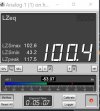Wonderful. Below is your post #87, and now you reference an article that uses clipping of single frequency sine waves in the "analysis"... and I was being misleading in using test tones?

Now, the problem with the analysis in your reference is that it isn't quite complete. Its author made his "conclusion" without fully completing his analysis, which is to run some numbers and show the amount of power in the harmonics generated by the clipping. He just lazily presumed the harmonics will be highly hazardous to tweeters.
Here is figure 2 from the article. Let me take for example the point at Vp/Vc = 2. The amplitude of H3 looks to be about 0.27 from the figure. So, the power of H3 will be 7.3% of a signal with an amplitude of 1 (assuming the impedance are roughly flat with frequency). The higher harmonics (H5, H7 ... etc.), as can be seen from the figure to be all < 0.1, give negligible contributions and are ignored.
View attachment 201285
What the author failed to consider is that, if the amplifier doesn't clip, the unclipped signal will have an amplitude of 2, which means 4X power of a signal with amplitude of 1.
To summarize, with the amplifier clipping at Vp/Vc = 2, higher harmonics of ~0.073 units of power are created (and are presumably all sent to the tweeter). However, if there is no clipping, the power to the woofer is 4 units. Therefore, if clipping will fry this speaker but it is OK with unclipped signal, that means its tweeter will have to have <2% the power handling capability of the woofer. And this is using a "misleading" test signal with contrived conditions to give the worst case scenario.


